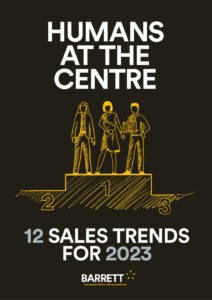The evidence is clear, the prevailing business model of the last 50 years where profit and shareholder return have been put above everything else hasn’t been good for business, sustainability, or the wellbeing of employees, suppliers, customers, communities, and the planet. While very few have profited handsomely, it has shown to be at the expense of the majority, with dire consequences. No society can sustain this kind of rising inequality.
All of our annual Barrett 12 Sales Trends reports, but in particular the last three editions, have focused specifically on what leading-edge businesses and their sales operations are doing now and need to do to ‘help’ create the conditions for a sustainable and prosperous future that includes healthy, regenerative supply chains and the wellbeing of people and the planet. No longer a pipedream, these trends are going mainstream with more organisations, of all sizes, realising that nobody escapes the fate of our planet and that we need to make concerted efforts to shift toward a human-centred, fairer, more affordable, clean energy powered, and sustainable future. We are on the cusp of the fastest, deepest, most consequential transformation of human civilization in history.
Being Human-centred
The central piece of the puzzle to becoming a business that is profitable AND good for the planet, the communities it operates in, and its people, is how its leaders and people embrace humanity – being human-centred- as a central philosophy and practice that puts people at the heart of business both inside and outside their organisations.
Creating human-centric teams and cultures is about embracing strategies and practices that focus on delivering what’s best for humanity in the way we innovate, collaborate, lead and manage employees, care for customers, partner with suppliers, and foster healthy, mutually prosperous relationships when doing business and delivering value.
With the significant changes we’ve all experienced over the last two to three years in the way we work and live and the ever-present cataclysmic effects of climate change and outdated centuries old extraction models, it is clear businesses have been made fully aware of the significant impact humans have on business success across the supply and value chain and beyond: employees, clients, suppliers, and communities. From staff shortages to remote working, supply chain challenges, and how business impacts the natural world and human lives, to improvements in communications, innovation through network collaboration, and realising the true value of engaging with real humans not just AI, thriving organisations will be the ones that place the betterment of humanity at the centre of all their decision making and actions.
Human-centred AND Profitable
All boards and CEOs focus on their P&L – how to make money and stay in business. However, only focusing on making profit at the expense of being sustainable and human-centred is outdated and flawed. Making money and being human-centred are not mutually exclusive. It’s not an OR proposition, human-centred businesses are about AND; they’re about being businessworthy. Being businessworthy is about recognising that in business we can get the “making money” curve AND the “making a difference” curve to come together for better business and societal outcomes now and in the long term.
Human-centred businesses are more profitable than their profit ONLY focused peers.
Human-centred businesses have very high employee engagement and research[1] shows that these organisations outperform those with low employee engagement by 202%[2] and their people are 87% less likely to leave than those in organisations with low engagement.
Human-centred businesses are customer-centric and customer-centric organisations grow their revenue 1.7 times faster than others[3], have happier employees, and avoid race to the bottom tactics which is good news for their suppliers as well.
Human-centred leadership
Being businessworthy and human-centred requires a change in how we think and work as leaders. Human-centred leadership makes success happen with people, not despite them.
Human-centred leaders realise that supporting their people and nurturing a healthy culture isn’t a distraction from business goals– in fact, it’s deeply strategic and leads to better business outcomes. As I often say “We need to be more than leaders. We must evolve to become Stewards of Systems, Leaders of People, Managers of Process and Curators of Culture to create better businesses, communities, and societies for a sustainable world.”
Putting humanity back on the corporate map
Being human-centred is about putting humanity back on the corporate map and endorsing buying and selling experiences that treat people with dignity and respect underpinned by the principle ‘Above all do no harm’ at every level of the value chain.
Being human-centred means that we stop playing the short game – quarterly sales results and profit hits – and instead adopt a longer-term view that sees the medium and long-term impact our strategic decisions and actions have on the customer experience, employee retention and wellbeing, supply chains and partnerships, business growth, profitability, reputation, the natural world, and sustainability.
Smart businesses that proactively adopt a human-centred ethos and its practices have a much more positive impact on their employees, customers, suppliers, and the environment.
They know it’s good for business to be human-centred.
This Sales Trends Report explores the ethics and values, systems and strategies, processes and tools, and ideas and models that businesses and sales operations need to adopt to become truly human-centred and businessworthy.
You can download the full report here.
Humans at the Centre
Sales trend 1 – The Case for Human-centred Economics
What is a human-centred economy? What are its benefits? This sales trend answers these questions and provides a range of facts and examples to prove the point.
Sales trend 2 – The Moral Case for Human-centred Businesses
What is the purpose of a business? How did (some) businesses lose their moral compass? In the sea of moral disengagement that seems to be contaminating many businesses, there’s hope. This sales trend delves deep into the issue of moral disengagement, dehumanising businesses, and what we can do to revert that.
Sales trend 3 – Sell Like A Woman
A sales career is great for women and women are great for sales teams and sales leadership. Women bring qualities to sales that are different to those associated with the stereotypical salesperson and those are the qualities that make them outstanding. This sales trend explores women’s strengths and potential for sales and the challenges and biases they face.
Sales trend 4 – Human-centred Growth
What if we aimed to sell better and create value instead of extracting value and sell more in a finite world? This sales trend looks at the consequences of both approaches.
Sales trend 5 – The Human Approach to Procurement
The primary objective of procurement is to create value for an organisation. But the definition of value changes. This sales trend explores what human-centred procurement looks like and what it needs to do to keep delivering value.
Sales trend 6 – AI AND Humans
Technology, especially IT-related tools that help automate processes, improve data management, and support staff are critical for most sales operations today. But will replace humans in their roles. This trend looks at Artificial Intelligence (AI) and its role in a human-centric business.
Sales trend 7 – What Consumers Want
There’s no denying that the pandemic brought about drastic changes in the way we buy. This trend highlights some of the key shifts that businesses need to be aware of.
Sales trend 8 – Engaging Human-centred Sales Strategies
Underpinning Business Strategy, Sales Strategy should sit alongside Marketing Strategy as an equal partner in the building and driving of better business and sales outcomes. This sales trend examines why engaging, human-centred Sales Strategies are critically important to business success.
Sales trend 9 –Why we Desperately Need Human-centred Leaders
When we reflect on the last 50-70 years of economic, societal, and business progress, the leadership characteristics that have featured most prominently are: ‘charismatic’ or ‘strong’, ‘gets results’ or ‘visionary’, but these paradigms are no longer fit for purpose. This sales trend is about the rise of human-centred leadership and practices.
Sales trend 10 – Humans at the Centre of Buying and Selling
B2B buying-selling-servicing processes are often messy and go undocumented because they are personality driven, not process oriented. This sales trend describes the qualities and advantages of developing human-centred buying-selling-servicing processes.
Sales trend 11 – Mastering Human-Centred Learning
Who is at the centre of learning? Well, in corporate environments there are often competing priorities. This sales trend looks at where learning initiatives are going and what are the effects of human-centred learning.
Sales trend 12 – A New Era of Safety
What is Psychological Safety? What does a psychologically safe environment look (and feel) like? This sales trend explores this new era of safety.
You can download the complete report here.

Speak to us about your needs.
Barrett Sales Blog





